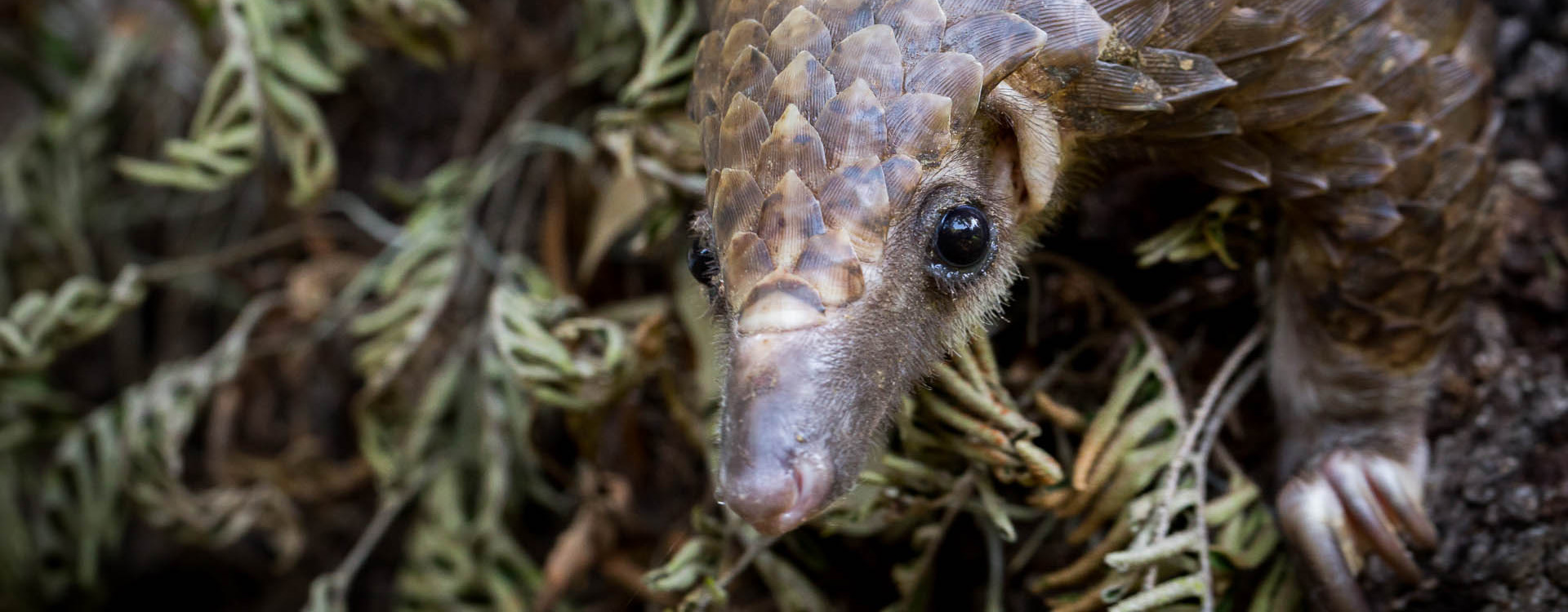“Experimental” - Thick-Tailed Pangolin
Acrylic on Canvas, 28” x 22” x 1.5"
Original Painting: $6,000.00
Limited Edition Archival Metal Print on Floating Frame: $1,000.00
Time to Completion: 195 Hours
Ounces of Paint: 52
Custom sizes and materials available for prints. Inquire here.
Detail Shot showing recycled paint flecks from my hands embedded in the black. Viewed from afar, the black resembles the night sky.
Photo: Dev Lee, courtesy of PangolinConservation.org, 2018
Human Impacts Resulting in Protected Status:
Trade & Hunting:
The most significant threat to the Thick-Tailed Pangolin [an anteater-like creature with huge scales] is hunting and poaching in India, Pakistan, and Sri Lanka. They serve as an excellent - and often relished - source of protein in India. The Thick-Tailed Pangolin is ritualistically hunted in many celebrations, such as 'Shikar Utsav' in Eastern India.
The scales of the Thick-Tailed Pangolin are used whole or in powdered form for traditional medicinals and curios. Their skin is used to manufacture high-end leather goods such as bags, boots, and shoes. It is thought that international trade of the Thick-Tailed Pangolin extends from Northeastern India to Myanmar and China.
In the last two decades, the hunting and poaching of the Thick-Tailed Pangolin has dramatically increased due to the decline of other Pangolin species, especially the Chinese and Sunda Pangolins.
Habitat Depletion:
Most of the Thick-Tailed Pangolin habitat range overlaps with high human populations densities. The suitable habitat space that is not in direct competition with humans is under threat by agricultural economy, improved irrigation systems, and pesticide use.
Conservation Efforts:
Protection & Hunting Regulations:
The Thick-Tailed Pangolin is internationally protected under the Convention on International Trade in Endangered Species of Wild Fauna and Flora [CITES].
In Bangladesh, all Pangolins are legally protected under the Wildlife (Conservation & Security) Act 2012.
In India, the Thick-Tailed Pangolin is included in Schedule I of the Wildlife Protection Act 1972.
In Pakistan, the Thick-Tailed Pangolin is protected under the Islamabad Wildlife (Protection, Preservation, Conservation, and Management) Ordinance, 1979 (Schedule III) and the North-West Frontier Province Wildlife (Protection, Preservation, Conservation, and Management) Act, 1975.
In Nepal, the Thick-Tailed Pangolin is listed as a Protected Animal in Schedule I of the National Parks and Wildlife Protection Act (1973, as amended 1993).
In Sri Lanka the Thick-Tailed Pangolin is listed as strictly protected (Schedule II) of the Fauna and Flora Protection (Amendment) Act (No. 22) 2009.
The the Thick-Tailed Pangolin is not listed as a protected species in China, but as an Appendix II listed species, they are considered a State Category II protected species under regulations including the Protection of Wildlife Act (1989), the Regulations on the Implementation of Protection of Terrestrial Wild Animals (1992) and the Regulations on Management of Import and Export of Endangered Species of Wild Fauna and Flora 2006, which subscribes to CITES.
In 2000, the export quota of wild caught Thick-Tailed Pangolins for commercial purposes became zero.
Profits:
Profits will go to Pangolin Conservation, which is dedicated to promoting the conservation, education, and research of the world’s various Pangolin species.
Source[s]:
International Union for Conservation of Nature and Natural Resources, 2014


